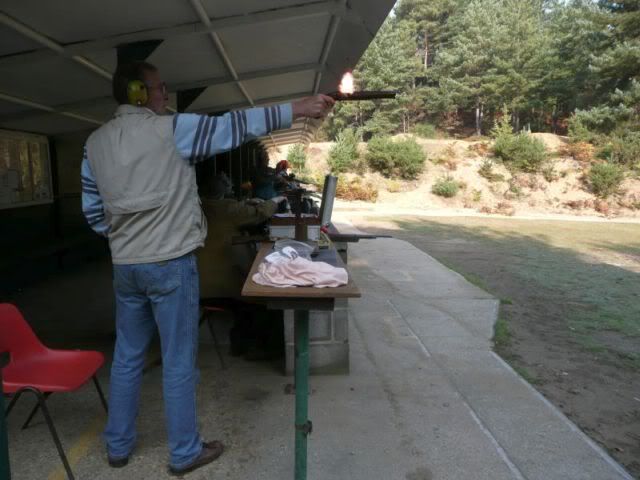Brian the Brit
36 Cal.
- Joined
- Aug 17, 2007
- Messages
- 66
- Reaction score
- 0
I took the pistol to the range this morning and came away with very mixed feelings. On the one hand I was delighted that I got it shoot after all these years but at the same time disappointed that I didn't even worry the target. How embarrassing!

The moment of ignition
I had cast a supply of excellent .575" balls from my new Lee mould (.593" bore) and cut some Irish linen patches that I pre-lubed with Stumpy's famous Moose Juice. The target was a standard 25 yard pistol target mounted on a 3ft x 3ft board set at 25 yards distance.
Initially I loaded 20 grains of fine powder using the same powder in the pan. To my astonishment, my first three shots all fired perfectly with little noticeable lock time. I had used a quill in the touch hole and not over-filled the pan as per advice given on this forum. The gun was a delight to shoot but despite the most careful examination of the target, no holes could be found.
After a couple of misfires due to poor sparking, I replaced the flint and fired another string of shots this time with 25 grains of powder. This certainly felt better but I'd be hard pressed to say why. It somehow felt 'just right'.
By now people had gathered to offer advice, spot the fall of shot and generally take the p**s. What soon became apparent was that the pistol (or perhaps 'I' in my ignorance) was shooting very high indeed, a full three or four feet over the target.
Adjusting my point of aim to four feet below the target I still couldn't hit it and although the elevation was now about right, windage was all over the place. So, out of a total of 20 shots, not a single one hit a nine square foot target board.
The recovered patches were perfect with a nice black circle and no signs of burning, tearing or blow-by. If anything, I would think that my patch material is perhaps a little thick (approx .020")as I really had to push hard on the rod to seat the ball on the powder particularly after a couple of shots had been fired.
I'm baffled. What am I doing wrong? I might as well have thrown the balls at the target. I knew that shooting a flintlock, particularly one that is 200 years old, would present a challenge but I never dreamt it would be quite this difficult.
Please advise. It's clear that I have a great deal to learn!

The moment of ignition
I had cast a supply of excellent .575" balls from my new Lee mould (.593" bore) and cut some Irish linen patches that I pre-lubed with Stumpy's famous Moose Juice. The target was a standard 25 yard pistol target mounted on a 3ft x 3ft board set at 25 yards distance.
Initially I loaded 20 grains of fine powder using the same powder in the pan. To my astonishment, my first three shots all fired perfectly with little noticeable lock time. I had used a quill in the touch hole and not over-filled the pan as per advice given on this forum. The gun was a delight to shoot but despite the most careful examination of the target, no holes could be found.
After a couple of misfires due to poor sparking, I replaced the flint and fired another string of shots this time with 25 grains of powder. This certainly felt better but I'd be hard pressed to say why. It somehow felt 'just right'.
By now people had gathered to offer advice, spot the fall of shot and generally take the p**s. What soon became apparent was that the pistol (or perhaps 'I' in my ignorance) was shooting very high indeed, a full three or four feet over the target.
Adjusting my point of aim to four feet below the target I still couldn't hit it and although the elevation was now about right, windage was all over the place. So, out of a total of 20 shots, not a single one hit a nine square foot target board.
The recovered patches were perfect with a nice black circle and no signs of burning, tearing or blow-by. If anything, I would think that my patch material is perhaps a little thick (approx .020")as I really had to push hard on the rod to seat the ball on the powder particularly after a couple of shots had been fired.
I'm baffled. What am I doing wrong? I might as well have thrown the balls at the target. I knew that shooting a flintlock, particularly one that is 200 years old, would present a challenge but I never dreamt it would be quite this difficult.
Please advise. It's clear that I have a great deal to learn!




